
|
|
| ||||||||||||||||||||||||||||||||||||||||||||||||||||||||
MITSCHER CLASS FLEET DESTROYERS (Frigates) (DL) |
||||
Name of Ship |
Hull No. |
Builder |
Launched |
Stricken Date |
MITSCHER |
DD-927 / DDG-35 / DL 2 |
Bath Iron Works, Maine |
26 Jan. 1952 |
01 June 1978 |
JOHN S. McCAIN |
DD-928 / DDG-36 / DL-3 |
Bath Iron Works, Maine |
12 July 1952 |
29 April 1978 |
WILLIS A. LEE |
DD-929 / DL-4 |
Bethlehem Steel, Quincy |
26 Jan. 1952 |
15 May 1972 |
WILKINSON |
DD-930 / DL-5 |
Bethlehem Steel, Quincy |
23 April 1952 |
01 May 1974 |
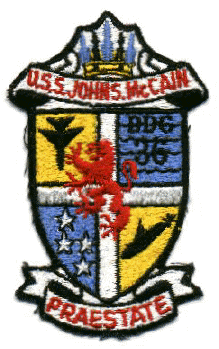 FRAM:
Although all MITSCHERS were completed by 1954, their
troublesome boilers required constant maintenance to keep them sea worthy. All
four MITSCHER class ships underwent FRAM beginning in April 1960 with the
average time taking 1 year. Besides boiler work, other modifications included
the replacement of the three inch guns. While newer enclosed 3-inch/70
caliber guns were installed in 1957-58 to replace the existing "open-mount"
3-inch/50 caliber guns, the aft mounted 3-inch/70 caliber twin mounting was
removed as well as the four 20mm anti-aircraft twin mounts during FRAM for the
DASH helicopter platform. The DASH hangar
was installed by placing it above the torpedo room aft of the No. 2 stack.
This required the SPS-8 Radar to be moved to a top the aft funnel.The depth charge rack and MK 108 WEAPON ALPHA was
also removed to accommodate the
increased weight of the new 3-inch/70 caliber twin mounts.
FRAM:
Although all MITSCHERS were completed by 1954, their
troublesome boilers required constant maintenance to keep them sea worthy. All
four MITSCHER class ships underwent FRAM beginning in April 1960 with the
average time taking 1 year. Besides boiler work, other modifications included
the replacement of the three inch guns. While newer enclosed 3-inch/70
caliber guns were installed in 1957-58 to replace the existing "open-mount"
3-inch/50 caliber guns, the aft mounted 3-inch/70 caliber twin mounting was
removed as well as the four 20mm anti-aircraft twin mounts during FRAM for the
DASH helicopter platform. The DASH hangar
was installed by placing it above the torpedo room aft of the No. 2 stack.
This required the SPS-8 Radar to be moved to a top the aft funnel.The depth charge rack and MK 108 WEAPON ALPHA was
also removed to accommodate the
increased weight of the new 3-inch/70 caliber twin mounts.  service for 4 years.
During that conversion the TARTAR missile launcher and ASROC systems were
installed on MITSCHER and JOHN S. McCAIN. However, when it became clear that the
TARTAR surface-to-air-missile (SAM) system did not work as well as expected,
WILLIS A. LEE (DL-4 seen right) and
WILKINSON did not receive the conversion.
service for 4 years.
During that conversion the TARTAR missile launcher and ASROC systems were
installed on MITSCHER and JOHN S. McCAIN. However, when it became clear that the
TARTAR surface-to-air-missile (SAM) system did not work as well as expected,
WILLIS A. LEE (DL-4 seen right) and
WILKINSON did not receive the conversion.
![]()
MITSCHER CLASS FLEET DESTROYERS (Frigates) (DL) SPECIFICATIONS |
|
Displacement: |
3,331 tons light, 3,642 tons standard and 4,855 tons FULL LOAD |
Dimensions: |
494 feet long x 50' beam x 26' Draft |
Guns: |
2 qty, 5-inch/54 Caliber Single dual purpose Gun Mounts; rapid fire,
radar controlled
|
ASW Weapons: |
2 qty, DASH Helicopters, 6 homing torpedo tubes (2 qty, MK 32 Triple
Torpedo mounts) and 4 qty 21-inch fixed tubes.
|
Electronics: |
RADAR
|
Boilers (DL-2 and DL-3): |
Four Controlled Circulation Type 1, Foster Wheeler Boilers operating pressure 1225 psi at 950 degrees F. |
Boilers (DL-3 and DL-4): |
Four Foster Wheeler Drum-Type Boilers operating pressure 1200 psi at 965 degrees F. |
Machinery (DL-2 and DL-3): |
2 General Electric propulsion turbines each coupled to a General Electric locked-train double reduction gears. 2 Shafts, 80,000 SHP = 35 Knots |
Machinery (DL-3 and DL-4): |
2 Westinghouse propulsion turbines each coupled to a de Laval locked-train double reduction gears. 2 Shafts, 80,000 SHP = 35 Knots |
Oil Fuel: |
5,288 barrels NSFO and 170 barrels of Diesel Oil = 740 tons |
Radius: |
At 4,855 tons full load maximum speed is 36.5 knots with endurance of 4,500 miles at 20 knots |
Complement: |
Allowance: 339 (19 officers, 320 enlisted men)
|
![]()
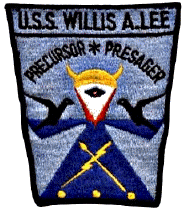 The MITSCHER's Steam plant issues dogged the class. Maintenance was very
difficult. Automated controls were complex and sensitive, and the steel used in
the plant could not be welded by ship's company resulting in serious reliability
issues. The 40 missile TARTAR battery
which had only a single arm to launch the missiles, and whose performance
was criticized as "non-effective" added unacceptable topside weight.
Together these problems doomed
the unconverted WILLIS A. LEE and WILKINSON. They were decommissioned after only 15
years of service in
The MITSCHER's Steam plant issues dogged the class. Maintenance was very
difficult. Automated controls were complex and sensitive, and the steel used in
the plant could not be welded by ship's company resulting in serious reliability
issues. The 40 missile TARTAR battery
which had only a single arm to launch the missiles, and whose performance
was criticized as "non-effective" added unacceptable topside weight.
Together these problems doomed
the unconverted WILLIS A. LEE and WILKINSON. They were decommissioned after only 15
years of service in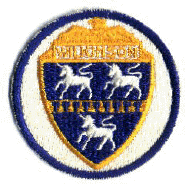 1969. The "converted"
MITSCHER and JOHN S. McCAIN (owing to their
re-boilering) were able to serve an additional ten years beyond their sister
ships and were finally decommissioned in 1978 after 25 years of
service.
1969. The "converted"
MITSCHER and JOHN S. McCAIN (owing to their
re-boilering) were able to serve an additional ten years beyond their sister
ships and were finally decommissioned in 1978 after 25 years of
service.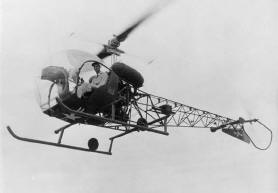 1.
Operating from the USS MITSCHER (DL-2) in February 1957 off the coast of Key
West, Florida, a piloted, Bell model HUL-1 Helicopter successfully flew to and
from MITSCHER carrying MK 43 Torpedoes demonstrating that a helicopter assigned
with torpedo carrying-tasks could operate from a U.S. Naval destroyer. This was
the first time the helicopter had been used for this purpose!
1.
Operating from the USS MITSCHER (DL-2) in February 1957 off the coast of Key
West, Florida, a piloted, Bell model HUL-1 Helicopter successfully flew to and
from MITSCHER carrying MK 43 Torpedoes demonstrating that a helicopter assigned
with torpedo carrying-tasks could operate from a U.S. Naval destroyer. This was
the first time the helicopter had been used for this purpose!
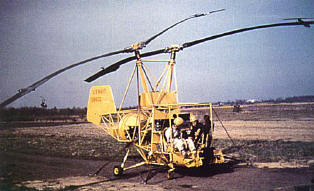 2.
Operating from the USS MITSCHER (DL-2) on 23 May 1957, a droned KAMAN HTK-1
helicopter (seen right) called the "Yellow Peril", carrying a safety pilot,
successfully operated from the ship in the area of Narragansett Bay,
Massachusetts. Landing on the Fantail (MITSCHER would
not receive a landing platform until 1960) of the ship, numerous
takeoffs and landings were performed from the controllers on-board MITSCHER.
These tests validated the concept that a drone helicopter could operate from a
destroyer-sized vessel.
2.
Operating from the USS MITSCHER (DL-2) on 23 May 1957, a droned KAMAN HTK-1
helicopter (seen right) called the "Yellow Peril", carrying a safety pilot,
successfully operated from the ship in the area of Narragansett Bay,
Massachusetts. Landing on the Fantail (MITSCHER would
not receive a landing platform until 1960) of the ship, numerous
takeoffs and landings were performed from the controllers on-board MITSCHER.
These tests validated the concept that a drone helicopter could operate from a
destroyer-sized vessel.
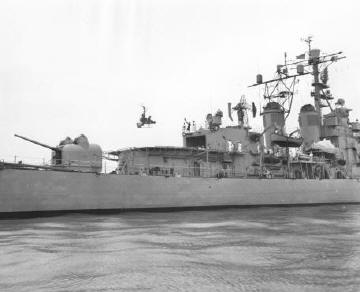 3.
Operating from USS MITSCHER (DL-2) on 01 July 1960,
a droned GYRODYNE model DSN-1 helicopter, with safety pilot, conducted the first
at-sea landing off the coast of Long Island, New York; flying from Gyrodyne's
manufacturing facility. The
DSN-1 helicopter, a droned version of
Gyrodyne's XRON helicopter for the Marine Corp,
was built under contract with the Navy for GYRODYNE to build a dedicated
remote-controlled helicopter expressly for the delivery of torpedoes for the
Drone Anti-Submarine Helicopter (DASH) program. The DASH system was created
under the Fleet Rehabilitation and Modernization (FRAM) reconstruction program
as part of a new weapon system to give destroyers a weapons range which equaled
the long-range detection ranges of the SQS-23 Sonar system which FRAM also
provided. The DSN-1, powered by a 72-Hp Porsche reciprocating engine was the
developmental model for the
turbine-powered QH-50 series of drone helicopters. On July 1, 1960 the DSN-1
made several takeoffs and landings while the MITSCHER varied course and
speed. These tests were the first for the DSN-1 at-sea and were conducted with
MITSCHER enroute to summer training off Guantanamo Bay, Cuba. At this time,
3.
Operating from USS MITSCHER (DL-2) on 01 July 1960,
a droned GYRODYNE model DSN-1 helicopter, with safety pilot, conducted the first
at-sea landing off the coast of Long Island, New York; flying from Gyrodyne's
manufacturing facility. The
DSN-1 helicopter, a droned version of
Gyrodyne's XRON helicopter for the Marine Corp,
was built under contract with the Navy for GYRODYNE to build a dedicated
remote-controlled helicopter expressly for the delivery of torpedoes for the
Drone Anti-Submarine Helicopter (DASH) program. The DASH system was created
under the Fleet Rehabilitation and Modernization (FRAM) reconstruction program
as part of a new weapon system to give destroyers a weapons range which equaled
the long-range detection ranges of the SQS-23 Sonar system which FRAM also
provided. The DSN-1, powered by a 72-Hp Porsche reciprocating engine was the
developmental model for the
turbine-powered QH-50 series of drone helicopters. On July 1, 1960 the DSN-1
made several takeoffs and landings while the MITSCHER varied course and
speed. These tests were the first for the DSN-1 at-sea and were conducted with
MITSCHER enroute to summer training off Guantanamo Bay, Cuba. At this time,
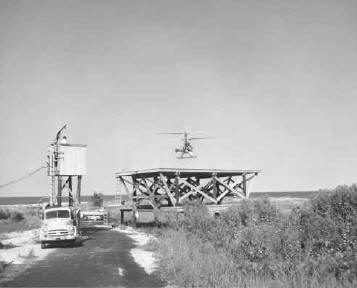 MITSCHER was homeported at Newport, R.I. and was under the command of Commander
Maylon T. Scott, USN.
MITSCHER was homeported at Newport, R.I. and was under the command of Commander
Maylon T. Scott, USN.
![]()
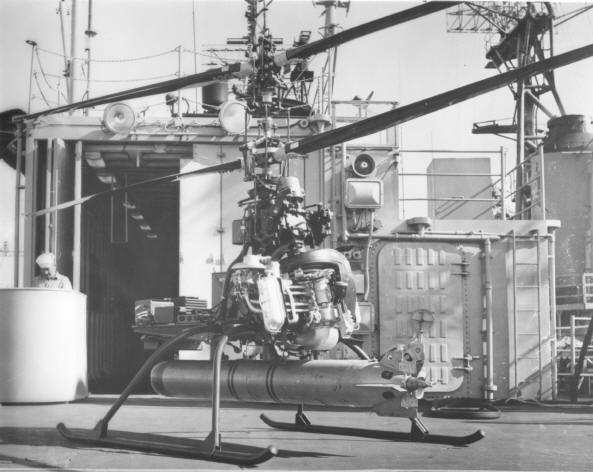
Without the safety pilot aboard, the QH-50A made the first unmanned helicopter landing aboard the USS Hazelwood (DD-531) while at sea on December 7, 1960. In subsequent operational evaluations off Key West, Florida, 38 flights were made from the Hazelwood and 22 simulated ASW missions confirming the feasibility of the DASH weapon system. The Hazelwood would later be converted as the trial ship for DASH development.
![]()
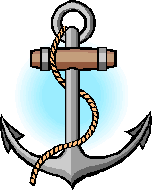
 Many
thanks to ALL the Crewman of the Four MITSCHER Class Destroyer Leaders who
supplied information and assistance to us for the building of this page so that
their history could be presented here.
Many
thanks to ALL the Crewman of the Four MITSCHER Class Destroyer Leaders who
supplied information and assistance to us for the building of this page so that
their history could be presented here.
![]()
![]()
|
The name "Gyrodyne" in its stylized
form above, is the Trademark of and owned by the Gyrodyne Helicopter Historical
Foundation; unauthorized use is PROHIBITED by Federal Law. All Photographs, technical specifications, and
content are herein copyrighted and owned exclusively by Gyrodyne Helicopter
Historical Foundation, unless otherwise stated. All Rights Reserved
©2013. |